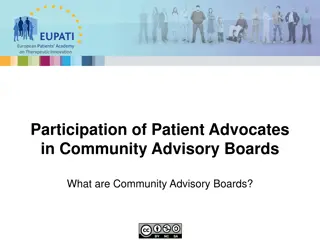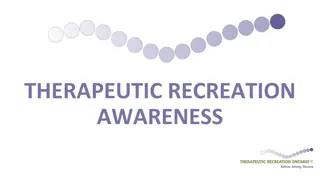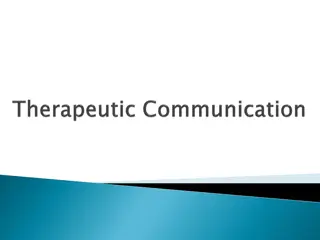Understanding Patient-Reported Outcomes in Therapeutic Innovation
Patient-Reported Outcomes (PROs) are gaining importance in therapeutic innovation to capture how patients feel about their treatment beyond clinical effectiveness. The European Patients Academy emphasizes the significance of measuring PROs through tools like Patient-Reported Outcome Measures (PROMs) to understand the patient perspective, well-being, and treatment acceptability. These insights provide valuable information that may not be captured by traditional clinical measurements, thus enhancing patient-centered care and treatment adherence.
Download Presentation

Please find below an Image/Link to download the presentation.
The content on the website is provided AS IS for your information and personal use only. It may not be sold, licensed, or shared on other websites without obtaining consent from the author. Download presentation by click this link. If you encounter any issues during the download, it is possible that the publisher has removed the file from their server.
E N D
Presentation Transcript
European Patients Academy on Therapeutic Innovation Patient-Reported Outcomes (PROs) Assessment
Measures of Clinical Effectiveness European Patients Academy on Therapeutic Innovation Measures of clinical effectiveness typically reflect outcomes that are important to patients, such as: symptoms, morbidity, or mortality. Sometimes, outcomes e.g. a heart attack, a malignant growth (cancer), or death, can be identified and measured using a clinical definition by someone other than the patient. 2
How does the patient feel? European Patients Academy on Therapeutic Innovation There is increasing awareness that treatments should be clinically effective and economically efficient, but also acceptable and desirable to patients. Clinical effectiveness measures cannot measure how a patient feels or functions or what they want to achieve from a treatment. Measuring this element of acceptability requires patient- based evidence that includes measures of well-being. 3
Patient-Reported Outcome Measures (PROMS) European Patients Academy on Therapeutic Innovation There has been an increasing focus on the development of patient - reported outcomes (PROs). PROs are based on a patient s perception of a disease and its treatment - adapted from the European Medicines Agency (EMA) s definition. Patient-reported outcome measures (PROMs) are the tools used to measure and collect data on PROs. 4
Why are PROs important? European Patients Academy on Therapeutic Innovation Patient-reported outcomes are important because they provide a patient perspective on a disease/treatment. This might not be captured by a clinical measurement but may be as important to the patient and the adherence to the treatment as a clinical measurement. 5
Example European Patients Academy on Therapeutic Innovation Imagine a scenario in which a patient is diagnosed with chronic obstructive pulmonary disease (COPD). A quick look for a review of clinical studies for treatments of COPD reveals the following: Tiotropium reduced the number of participants experiencing one or more exacerbations compared with [long-acting beta agonists] (odds ratio (OR) 0.86; 95% confidence interval (CI) 0.79 to 0.93). There was no statistically significant difference in forced expiratory volume in one second (FEV(1)) or symptom score between tiotropium and LABA-treated participants. What do these findings say about how the patient felt about the new treatment and how they were able to perform their daily activities? 6
What do these outcomes mean for the patient? European Patients Academy on Therapeutic Innovation Further understanding about what these outcomes mean for the patient is needed: Is an exacerbation something that leads to hospitalisation? Or is it a coughing spell that can take place at home? Is the laboratory test FEV(1) something that directly affects how patients function? Does the symptom score capture how the patient felt or is it an objective measure of symptoms? 7
PROs are focussed on real benefits for the patients European Patients Academy on Therapeutic Innovation Unlike standard clinical outcomes, PROs give us unique insights into how a therapy can affect a patient. Individuals with the exact same health status, diagnosis, or disease may have different perceptions about how they feel and function. Their ability to cope with limitations and disability and other factors can alter perception about satisfaction with life. PRO measures are important as they can lead to a medical science that is more focused on real benefits achievable for the patients. 8
Well-being measures European Patients Academy on Therapeutic Innovation The ability to measure well-being as an outcome becomes especially important in clinical situations where the primary goal of treatment is patient well-being, rather than prolonging life or reducing disease events. For example, patients diagnosed with a chronic disease that is not immediately life-threatening may be most concerned with their emotional state and their ability to live a full life. A patient with a terminal illness may be more concerned with their level of comfort, their ability to live longer, and the impact of their illness on loved ones. 9
How are PROs measured? European Patients Academy on Therapeutic Innovation PROs must be carefully defined so that they capture information that is important to patients. This information must be measured accurately and as much as possible, in a way that makes it comparable with other measurements. Poor development of concepts will result in the measurement of outcomes that are not important to patients, however accurately measured. Poor measurement methods will identify an outcome that is important to patients, but which is difficult to interpret. 10
What to measure? European Patients Academy on Therapeutic Innovation Deciding precisely what to measure and how detailed the question formulation must be is critical. Vague questions may provide vague information that is not useful. For example, a patient may be asked, How are you feeling on a scale of 1 to 10? (1 being poorly and 10 being extremely well). This is very imprecise. More specific questions relating to emotional wellbeing influenced by mobility, breathing, etc., will provide more detailed and specific information. 11
Concepts in PROs European Patients Academy on Therapeutic Innovation In PROs a concept is the object of measurement, such as: a symptom or group of symptoms, effects on a particular function or group of functions, or a group of symptoms or functions shown to measure the severity of a health condition. Once the concept is agreed, patients are asked questions relating to it. These questions are known as items . Items are asked in order to understand the change in the concept. 12
Example European Patients Academy on Therapeutic Innovation Investigators researching the response of patients with COPD to a therapy may recognise that the patients may find performing tasks more difficult in the morning. The concept that they decide to measure is the burden and extent of morning symptoms and the ability of patients to perform activities at that time of day. Items to capture this concept may be questions such as: Did you wash yourself this morning other than your face, i.e. body wash, shower, bathe? Did you get dressed this morning? and Did you walk around your home early this morning after taking your medicine? 13
Example European Patients Academy on Therapeutic Innovation The optional answers that patients are given to these questions may include a range of responses, such as: Yes, I did it myself. Yes, but I needed help. No, I was unable to. No, I did not for other reasons. Patients may also be given an option to respond to a follow up question, such as: How difficult was it for you to perform this task? 14
Concepts in PROs European Patients Academy on Therapeutic Innovation In some cases, caregivers or doctors have developed the concept attached to a disease and patient group. However, the need for patients to help identify and develop concepts themselves has become increasingly recognised. 15
Major concepts measured in PROs European Patients Academy on Therapeutic Innovation 1. Health-related Quality of Life (HRQoL) Represents the patient s evaluation of a health condition, and its treatment on their daily life including: physical function, psychological function, social function, role function, emotional function, well-being, vitality, health status etc. 16
Major concepts measured in PROs European Patients Academy on Therapeutic Innovation 2. Patient satisfaction: evaluation of treatments, patient s preference, healthcare delivery systems and professionals, patient education programs, and medical devices. 17
Major concepts measured in PROs European Patients Academy on Therapeutic Innovation 3. Physical functioning Physical limitations and activity restrictions, including: walking, mobility, sleep, self-care, sex, and disability. 18
Major concepts measured in PROs European Patients Academy on Therapeutic Innovation 4. Psychological state Positive or negative affect and cognitive functioning, including: anger, alertness, self-esteem, sense of well-being, distress, and coping. 19
Major concepts measured in PROs European Patients Academy on Therapeutic Innovation 5. Signs and symptoms Reports of physical and psychological symptoms or sensations not directly observable, including: energy, fatigue, nausea, and irritability. 20
Major concepts measured in PROs European Patients Academy on Therapeutic Innovation 6. Social functioning limitations in work or school, participation in community. 7. Treatment adherence reports or observations of actual use of treatments. 21
Major concepts measured in PROs European Patients Academy on Therapeutic Innovation 8. Utility or usefulness, is the (perceived) ability of something to satisfy needs or wants. In health economics, utilities measure the strength of patient preferences, for example, how important various factors are to patients, such as: symptoms, pain, and psychological health. The impact of new treatments on these concepts and therefore on quality of life (QoL), can be calculated. 22
How to interpret PROs? European Patients Academy on Therapeutic Innovation Measurement methodology is very important in PRO research. Once the concept and the items are identified and set out, careful decisions need to be made about: how the questions are delivered to patients, when the questions are delivered to patients, how answers are recorded, and how the data is interpreted. 23
Using Questionnaires or Surveys European Patients Academy on Therapeutic Innovation PROs are measured with questionnaires or surveys that are either: completed by the patients themselves, completed by the patient in the presence of the researcher, or completed by the researcher through face-to-face interview or by telephone interview. There are strengths and weaknesses to the different approaches to collecting information. While the use of trained interviewers reduces errors and ensures surveys are completed, trial/treatment resources may not allow for this. 24
Using Questionnaires or Surveys European Patients Academy on Therapeutic Innovation It is crucial that approaches and methods used address patients perceptions and the actual concepts being measured rather than focusing on the interviewer and on the way questions are asked. For example, morning symptoms are more reliable if the questionnaire is administered in the morning than if the questionnaire is completed later in the day. Researchers who develop these tools/instruments must make every attempt to ensure that they are measuring concepts important to patients in a way that is repeatable and understandable. 25
Important aspects to be considered in PROMs Property European Patients Academy on Therapeutic Innovation Description Reliability Measurements are repeatable and consistent, and must distinguish between changes in response and changes due to errors in administration Validity Face validity Measures what it is intended to measure Criterion validity Measurements of aspects that are actually important to patients Content validity The extent to which an instrument covers all key dimensions of relevance Construct Validity Measurements reflect what is happening in reality Responsiveness Change in measures in response to change in HRQoL Practicality Measurements are easily obtained, and the instrument is easy to administer. Interpretability Significance of measurements are understood by clinicians or researchers rather than patients and others 26
HTA and patient involvement European Patients Academy on Therapeutic Innovation Many health technology assessment (HTA) bodies rely on the synthesis of evidence to make recommendations regarding access to new therapies. HTA relies largely on quantitative research from clinical data and patient experience, as provided by PROMs. An important part of patient involvement in the use of PROs should occur during the stages of clinical development. However, once a submission is already made for a marketing authorisation, it can be too challenging for this kind of involvement. Many PROMs have not been developed with the extensive participation of patients. 27
Role of patient organisations European Patients Academy on Therapeutic Innovation PROMs do not necessarily measure concepts important to patients. There are activities patient groups can do to address this before, during, and after PROM development: Evaluating and reviewing PROMs, Identifying the need for PROMs, Developing and evaluating conceptual and/or theoretical frameworks, Providing concepts through PRO awareness, Endorsing PROMs, Highlighting needs, and Reviewing HTA outputs. 28
References European Patients Academy on Therapeutic Innovation Food and Drug Association (2009). Guidance for industry. Patient-reported outcome measures: Use in medicinal product development to support labelling claims. Retrieved 6 January 2016 from http://www.fda.gov/ucm/groups/fdagov- public/@fdagov-drugs- gen/documents/document/ucm193282.pdf 29
References European Patients Academy on Therapeutic Innovation PROQOLID (2015). Free access level: Concept of interest . Retrieved 6 January, 2016, fromhttp://www.proqolid.org/about_proqolid Staniszewska, S., Haywood, K.L., Brett, J., Tutton, L. (2012). Patient and public involvement in patient- reported outcome measures: Evolution not revolution . The Patient, 5(2), 79-87. 30























